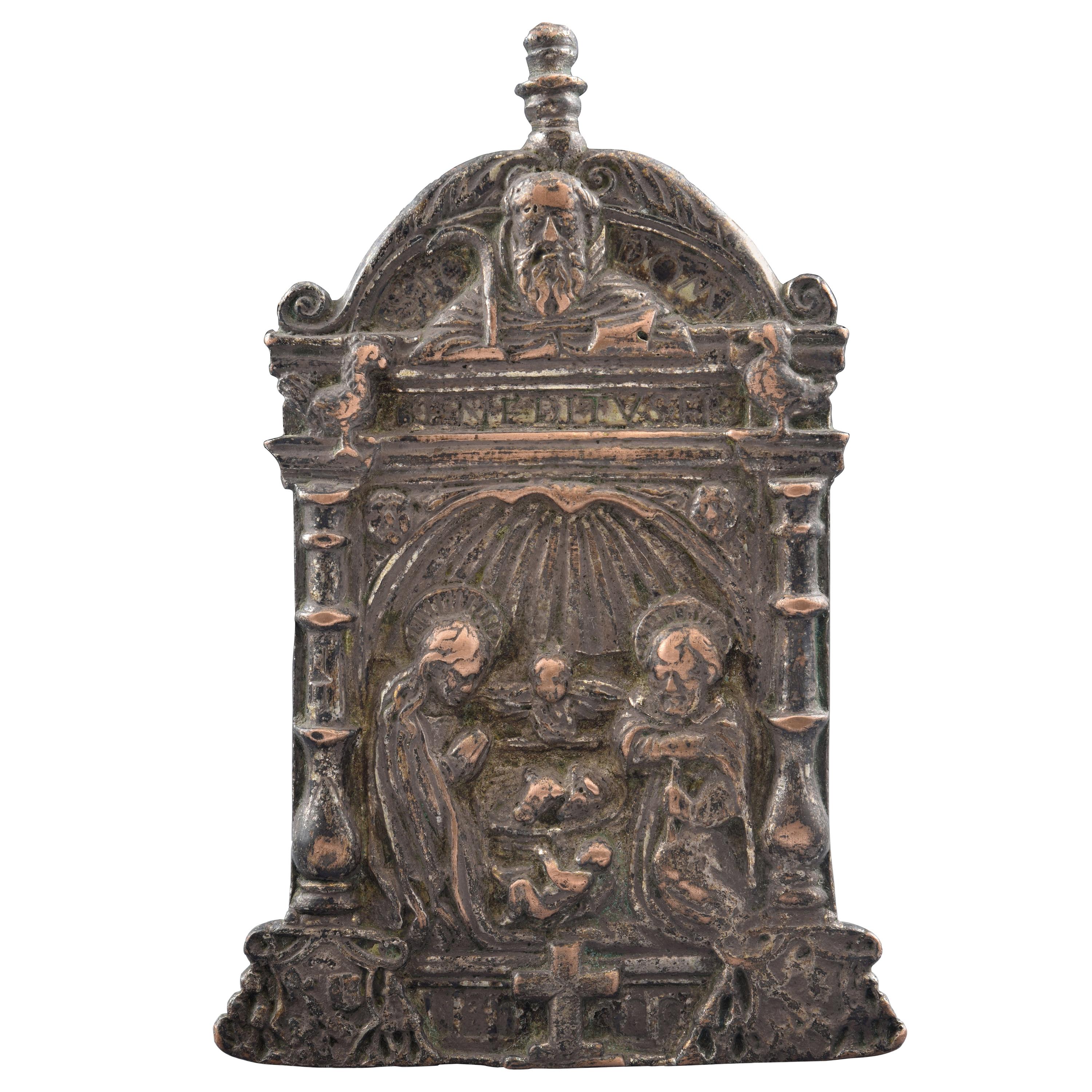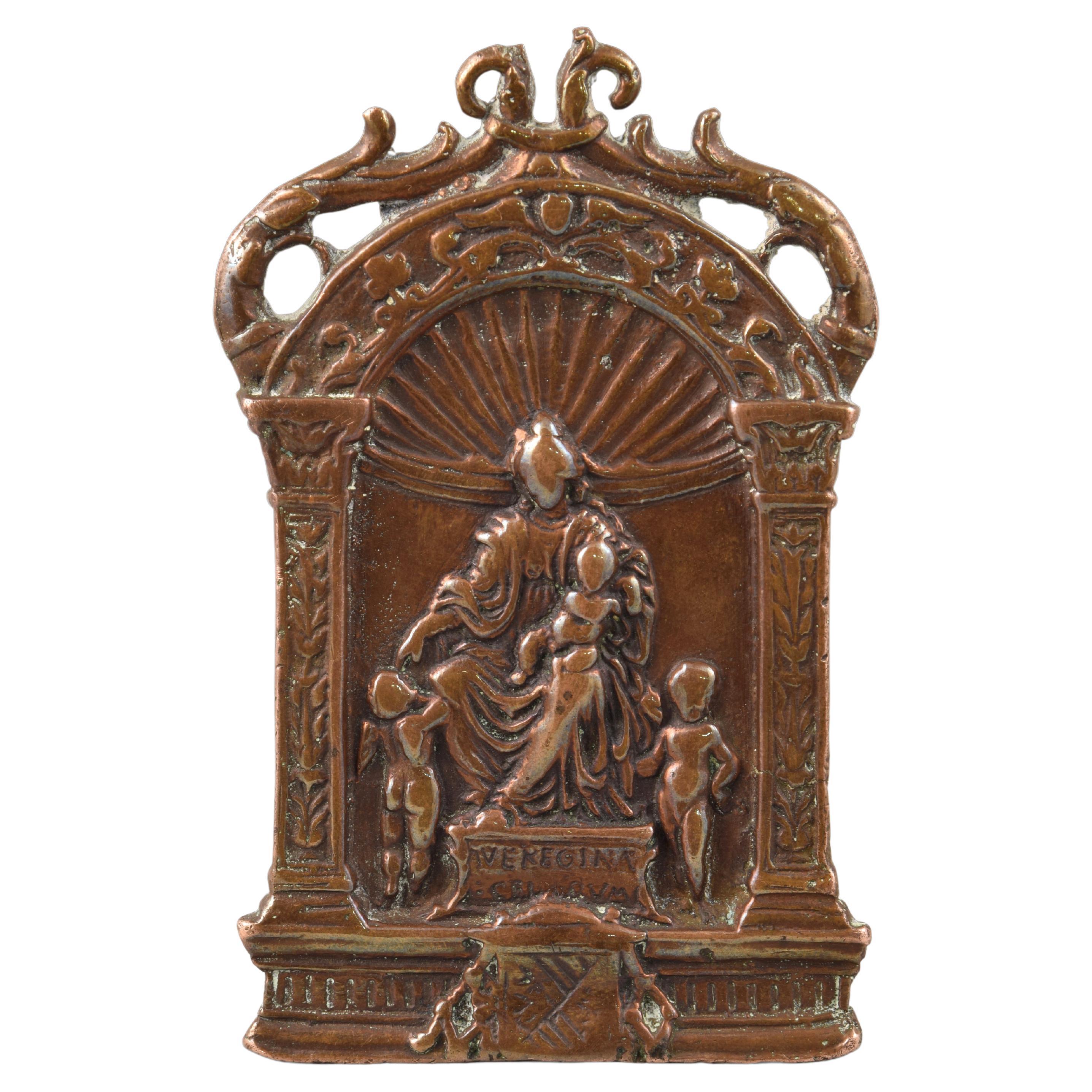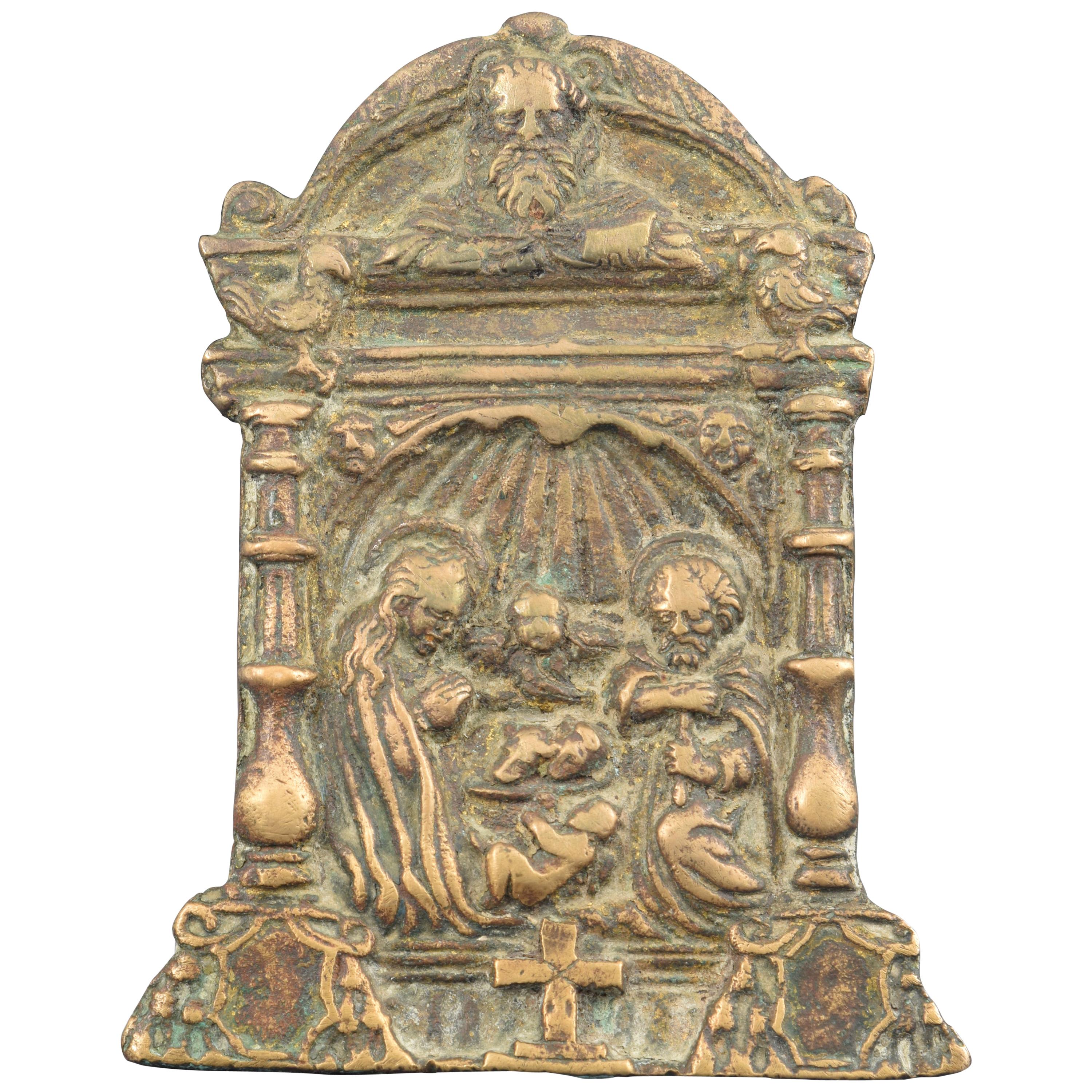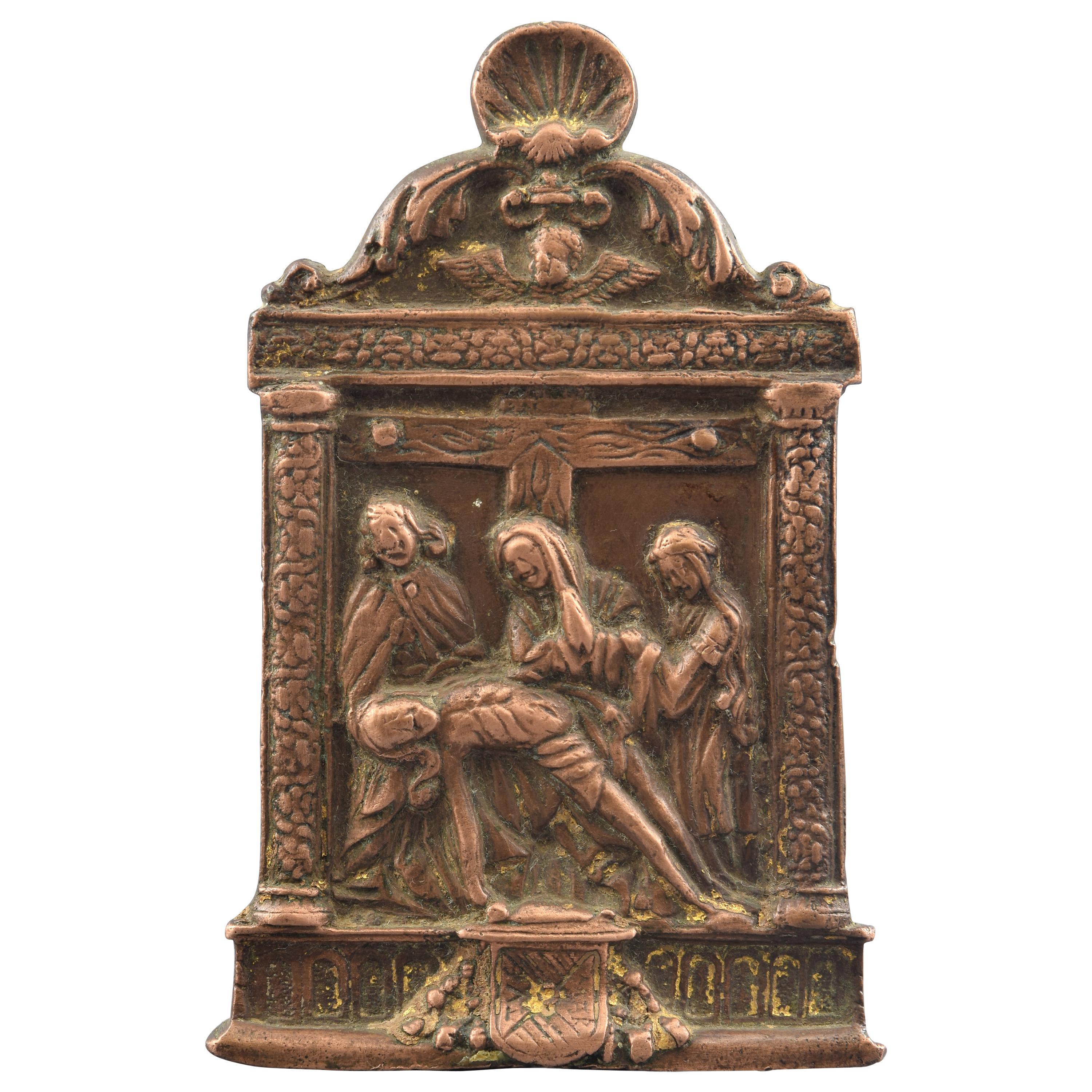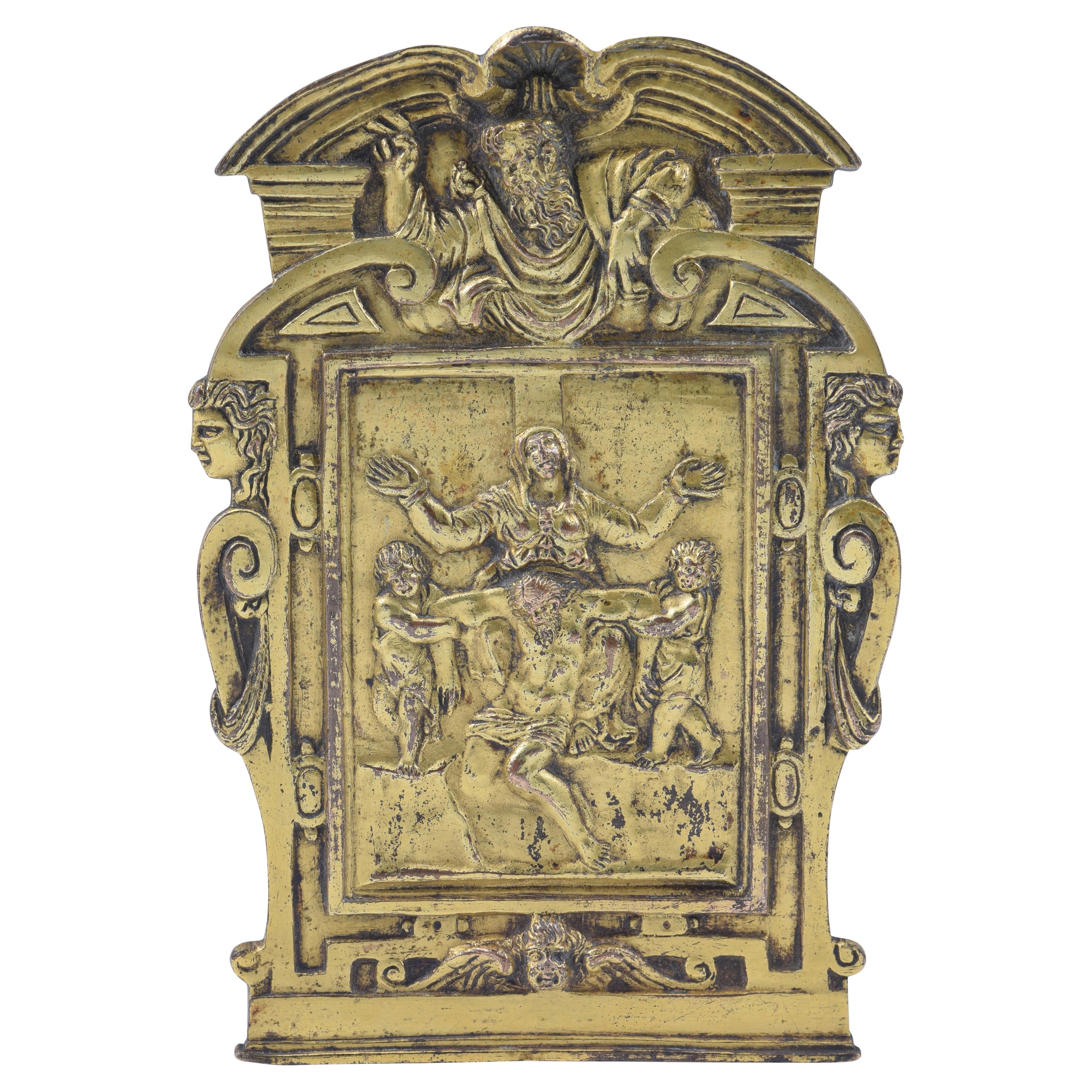Items Similar to 15th century North Italian Gilt Bronze Pax of the Lamentation
Want more images or videos?
Request additional images or videos from the seller
1 of 5
15th century North Italian Gilt Bronze Pax of the Lamentation
About the Item
Anonymous
Second half of the 15th century; Northern Italy, possibly Milan
Gilt bronze
Approximate size: 17.2 x 13 cm
The present pax probably derives from a finer original realized in more precious materials. For example, the vigor of its central motif is carved in such a way as to suggest the original artwork was conceived in carved stone or perhaps mother-of-pearl. The intricacy of its frame suggests a separate master adept in silverwork. Overall, this bronze pax likely preserves what must have been a precious original involving more than one artist. Suggesting the central relief was not originally integral with the frame is a singly known independent example, cast in bronze, and featuring a flange for setting into a pax frame, preserved in the Berlin Museum collections. Another independent example of the relief, set into a later pax frame is in the Louvre.
The relief itself depicts a Lamentation scene featuring the three Mary’s of the biblical narrative attending the corpse of Christ. Flanking the cross are the instruments of the Passion and in the background are motifs depicting the kiss of Judas and the washing of Pilate’s hands. Above the horizontal beam of the cross are the moon and sun.
The architrave of the pax features the inscribed text: IN TE DOMINE SPERAVI (I put my trust in you, Lord). This Latin inscription could suggest a possible Milanese origin as the frame itself relates to the artistic milieu of that region and the Latin verse itself was given special attention in the Milanese church during the end of the 15th century. For example, the widely celebrated composer, Josquin des Prez, under the employ of Cardinal Ascanio Sforza in Milan, composed the sacred frottola: In te Domine speravi, becoming a favorite within the Sforza court. Furthermore, the Duke, Ludovico Maria Sforza’s, interest in carved gems and other precious materials could indicate a possible commission of this type of artwork in late 15th century Milan.
This pax is particularly interesting in that it exemplifies the presence or appreciation of late Gothic Northern motifs within Italy, revealing the intersection of these cultures in turn-of-the-century Lombardy.
The handle on the reverse of the pax is broken along the bottom, probably due to a hard fall. However, its original design is observed on various other late 15th century paxes of the Lombard region. This style of handle was continually employed into the first quarter of the 16th century and its frequent use on paxes of this region and period suggest a common model born from a single prolific workshop and perhaps copied by later provincial foundries.
The quality of the present pax suggests it is contemporary and its gilding is rubbed through use and handling over time. Overall, this pax is particularly rare with only two other alike examples known in the art market, one of which was formerly in the collection of the Italian art scholar Charles Avery.
References and provenance available upon request.
- Dimensions:Height: 6.7 in (17.02 cm)Width: 5.11 in (12.98 cm)Depth: 1 in (2.54 cm)
- Style:Renaissance (Of the Period)
- Materials and Techniques:
- Place of Origin:
- Period:
- Date of Manufacture:Unknown
- Condition:Wear consistent with age and use.
- Seller Location:Leesburg, VA
- Reference Number:1stDibs: LU8166234816832
About the Seller
5.0
Vetted Seller
These experienced sellers undergo a comprehensive evaluation by our team of in-house experts.
Established in 2013
1stDibs seller since 2023
18 sales on 1stDibs
Typical response time: 6 hours
- ShippingRetrieving quote...Ships From: Leesburg, VA
- Return PolicyThis item cannot be returned.
More From This SellerView All
- 15th century Gilt Bronze Pax of the Virgin and Child, after DonatelloLocated in Leesburg, VAAnonymous, school of Donatello Second half of the 15th century; Northern Italy Approximate size: 13 x 7.6 cm The present relief of the Virgin and Child is largely considered derive...Category
Antique 15th Century and Earlier Italian Renaissance Religious Items
MaterialsBronze
- A 17th century Roman Altar Cross after Guglielmo della PortaLocated in Leesburg, VAA 17th century Roman altar cross after Guglielmo della Porta Approximate size: 67 x 27 cm The present altar cross, likely of Italian Roman origin, reprod...Category
Antique 17th Century Italian Renaissance Religious Items
MaterialsAgate, Lapis Lazuli, Bronze
- Ebony Wood and Gilt Bronze Reliquary Altar Cross After GiambolognaLocated in Leesburg, VAAnonymous (corpus after a model by Giambologna) circa 1700; Netherlandish or Northern Rhinish Ebonized wood, gilt bronze appliques and statuettes, textiles and relics Approximat...Category
Antique 1690s Dutch Baroque Religious Items
MaterialsBronze
- Yellow Marine Sponge Mounted on an Antique SocleLocated in Leesburg, VAA yellow marine sponge fixed to an antique socle. The yellow marine sponge, or aplysina fistularis, often called the ‘yellow candle sponge,’ is here appr...Category
20th Century Italian Renaissance Nautical Objects
MaterialsOrganic Material, Wood
- A large 16th century Italian etching of the Vision of St. Peter after TintorettoLocated in Leesburg, VAAN UNUSUALLY LARGE 16TH CENTURY ITALIAN ETCHING OF THE VISION OF ST. PETER AFTER JACOPO TINTORETTO Anonymous, after Jacopo Tintoretto Italy; 16th century Printed on laid paper with ...Category
Antique 16th Century Italian Baroque Prints
MaterialsPaper
- Pair of Natural Standing Brain Coral ObelisksLocated in Leesburg, VAA unique pair of natural standing brain coral obelisks. The bases smoothed for display. The largest of the two specimen is approximately 29 x 11.5 cm.Category
21st Century and Contemporary Unknown Organic Modern Nautical Objects
MaterialsCoral
You May Also Like
- Bronze Pax or Pax Board, 16th CenturyLocated in Madrid, ESPaper holder bronze. 16th century. Portapaz made of bronze with a flat handle in "that" on the back that presents a decoration in light relief framed in an architectural composition of classic taste. Under the columns of the sides two heraldic shields are presented; the center shows a Birth of Christ under a winged dome with heads of winged angels in the corners; flanked by two birds, at the top and under a semicircular arch, is the bust of Saint Dominic...Category
Antique 16th Century Spanish Renaissance Religious Items
MaterialsBronze
- Bronze Pax or Pax Board, 16th CenturyLocated in Madrid, ESPaper holder bronze, 16th century. Bronze paper holder with a flat curved handle on the back that features a relief decoration organized in the front through an architectural composition with a classical influence usual in the Renaissance. Under the columns on the sides there are two heraldic shields (without bonnet, laces with tassels on three levels) with a Latin cross in the middle zone; the center shows a birth of Christ under a winged dome with heads of winged angels in the corners; at the top and under a semi-circular arch, the bust of Saint Dominic...Category
Antique 16th Century Spanish Renaissance Religious Items
MaterialsBronze
- Bronze Pax or Pax Board, 16th CenturyLocated in Madrid, ESPeacekeeper. Bronze. Century XVI. Bronze purse with a handle on the back in the shape of an esse in the same material and a decoration in light relief on the front that shows, unde...Category
Antique 16th Century Spanish Renaissance Religious Items
MaterialsBronze
- Pax or Pax Board, Bronze, Spain, 16th CenturyLocated in Madrid, ESPaper holder bronze, 16th century. Portapaz made of bronze with an "asymmetric" handle on the back, which presents a decoration in light relief framed in an architectural compositio...Category
Antique 16th Century European Renaissance Religious Items
MaterialsBronze
- Gilt bronze pax board, Pietà. 16th-17th centuries, after Michelangelo BuonarrotiLocated in Madrid, ESPeacekeeper, Mercy. Golden bronze. Possibly Rome, last third of the 16th century-first quarter of the 17th century, following the model of Michelangelo Buonarroti. Gilded bronze pla...Category
Antique Early 17th Century European Renaissance Religious Items
MaterialsOther, Bronze
- "Madonna with Child and Angels". Italy, 15th-16th CenturiesLocated in Madrid, ESBronze in its color and gold, lapis lazuli, rock crystal, enamel. In the centre of the work is presented, enthroned, the figure of Mary, with a mantel (fireplace) on her shoulders and hair and holding on her knees the child, who appears addressing one of the angels. The virgin is also sheltered by an ogee arch supported on turned columns, and raised visually by steps. This composition achieves a very striking contrast: the dark bronze figure, in contrast to the lapis lazuli background and the part of the arch and the outside of it, in gilded bronze. Under the steps there is a heraldic enamel shield with a key on an azure background. The angels, kneeling, are flanking this figure, and, appearing in dark bronze, visually share the "category" of religious figures with Mary, while their (lower) position gives more status to both the Mother and Jesus. The rest of the composition is completed with a delicate landscape: constructions and walls on mountains, clouds in the sky, plants, stones, etc. To the outside, another lapis lazuli frame is placed decorated in the corners with appliques, giving way to carved and polychrome wood. The lapis lazuli is a semiprecious stone already known in the seventh millennium BC., found in deposits from the Caucasus to Mauritania. From the end of the middle ages, it increased its export to Europe, its use being more frequent since then both to use it as a pigment in paintings after grinding it (giving rise to the finest and most expensive of the blues, and of the colors in many occasions), as for backgrounds of paintings, incrustations in works of art, jewelry and, a little later, in the well-known "hard stone works". The figure of Mary still shows an influence of Gothic models, although more European than Italian, along with elements that could already show a closeness to the Renaissance: although the nakedness of Jesus is already shown in Gothic works (Madonna with Angels by Fra Angelico ), the creation of space by playing with the cloth in front of Christ can be appreciated in more advanced paintings (Virgin with Child by Domenico Ghirlandaio, National Gallery of London); the presence of a powerful throne can be seen frequently in Italian Madonnas of the Quattrocento (and before), but not quite as presented here. As for the landscape, it is necessary to compare it, for example, with that of the fresco of the Condotiero Guidoriccio de Fogliano (Simone Martini, finished in 1328). This is a work of great technical and aesthetic quality, not to mention the materials chosen for its creation, comparable only to outstanding examples from around the world, such as those preserved in the Palazzo Madama in Torino (Italy), where the coral It also has an important role. It is essential to mention, also, works such as the plate of hard stones (lapis lazuli between them) with a relief of Mary with the Child in...Category
Antique 16th Century Italian Renaissance Religious Items
MaterialsLapis Lazuli, Bronze, Enamel, Other
Recently Viewed
View AllMore Ways To Browse
Italian Stone Relief
Sacred Heart Ex Voto
10 Commandments
Austrian Menorah
Gothic Incense
Antique Italian Silver Ex Voto
Menorah Solid Silver
Tabernacle Niche
Vintage Inri Cross
Antique Advent Wreath
Antique Oak Church Lectern
French Giltwood Religious Jesus
Holy Water Wood Fonts
Miniature Bibles
Prie D
Antique Spanish Dolls
Cloisonne Crucifix
Relic Watches

